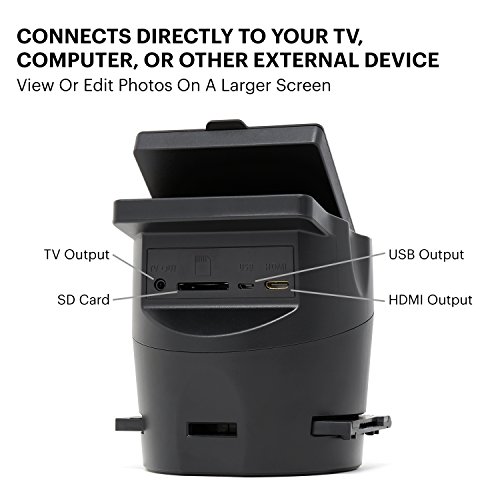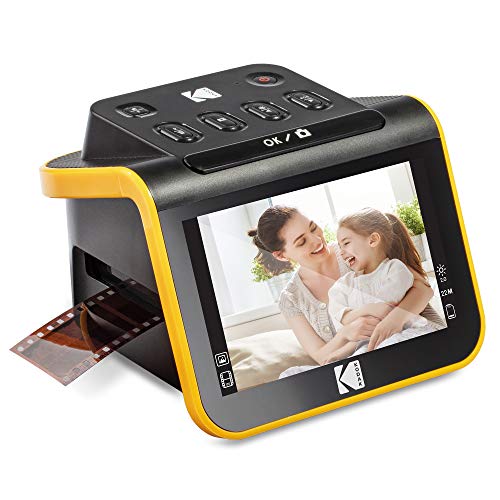The Best Slide Scanners

To help you find the perfect slide scanner, we continuously put forth the effort to update and expand our list of recommendable slide scanners. Our team collects, edits and publishes new information, in order to present it to you in an accurate, significant and neatly arranged way.
Our Picks
8 More Slide Scanner Alternatives
Table of Contents
Buying Guide
Slide Scanner Essentials
Slide scanners, also known as film or photo scanners, make it simple to transfer your analog images straight into a computer. In the old days, you would have had to make a print and then scan that, but slide scanner technology lets you cut right to the chase.
Why not just work with a regular office scanner? The problem has to do with the large image scanning beds that these machines use. You’ll have to align your tiny film strips and negatives with extreme precision to get consistent results. Even if you have faith in the steadiness of your hands, however, you’ll still need to repeat the process hundreds or thousands of times depending on how many slides you want to replicate. Using a machine made for the task dramatically reduces your workload.
Features That Are Worth Considering
Not all slide scanners are the same. Pay attention to the following characteristics so that you can make a smart choice for your next photo preservation project.
Media Compatibility
Are you scanning original 35 mm film negatives or a reel of 120 mm film? Do you want to replicate microscope slides or photo prints? Always pick a scanner that can accommodate the different media formats that you’re interested in preserving.
Film scanners typically feature various holders that ease the process of aligning your originals. For instance, the Epson Perfection V800 Photo Scanner has holders for 35 mm slides, 35 mm film strips, 4 x 5 inch prints and
6 x 20 cm medium format media. Canon’s CanoScan LIDE120, on the other hand, lacks a special film holder, so it's better for scanning photo prints.
Resolution
To reproduce the fine nuances of photographic prints and small slides, you need a scanner that can capture images at extremely high resolutions. The 1,200 dpi high setting on your regular flatbed may be okay for things like your kid’s drawings or your personal documents, but using it on photos and film will result in flaws, artifacts and lost details.
Choosing Your Hardware Capabilities
Is there such a thing as a perfect resolution? It all depends on the photos that you’re trying to scan. For example, if you’re copying an image produced by a camera that was slightly out of focus, then no amount of resolution can overcome the soft edges and blurriness present in the original. On the other hand, you’re almost sure to notice the effects of low-resolution scanning when you’re trying to duplicate an image that was initially clean and sharp.As a general rule, some photography buffs recommend starting at around 2,400 dpi and higher for stills. When converting movie film to video, people report being able to create quality HD content by starting at around 800 dpi for 35 mm formats.
It’s important to remember that these are just guidelines. Even within the world of once-commonplace formats like 35 mm, different manufacturers produced film products with unique dimensions and aspect ratios.
Leaving yourself with wiggle room is always best, so many people go for scanners with the highest resolution capacities they can find and then use software to downsample the resolution as needed. This strategy reduces the amount of image information that you lose along the way. For instance, the Plustek OpticFilm 8200i scanner has a steep learning curve, but it captures images at a whopping 7,200 dpi. It also includes optimizations for 35 mm film.
Computer Compatibility
It’s entirely up to you which side of the PC vs. Mac vs. Linux debate you fall on, but at the very least, make sure that your scanner is on the same team. Not all devices that claim to operate fine with Macs or PCs do so flawlessly, so if a manufacturer says that their software is compatible, don’t just take it on faith. Always be certain to check which versions of your operating system the software is verified to function with before buying.
Scanning images is a data-intensive process. Although USB 2.0 connections are fine for transferring limited amounts of information to your computer, you may want to choose a FireWire- or USB 3.0-equipped scanner to speed bigger batches along faster. Or go with an option like the 2,500 dpi Ion Pics 2 SD for built-in SD card data recording. Using self-contained scanners means that you don’t even have to fiddle with installing drivers or software.
Workflow
When you’re scanning many images, it pays to have assistance. Unfortunately, you might not be able to convince your friends or significant other that they should spend their weekends helping you load film into a scanner.
In such cases, options like Jumbl’s 22MP All-In-1 Film & Slide Scanner can make life much easier. This model accepts continuous film reels and incorporates a speed-load adapter system that makes it possible to feed in slides and negatives at much higher rates. It also features an LCD screen that lets you see what you’re scanning and perform some basic error-correction functions on the spot. The Plustek OpticFilm 135 offers a motorized solution for moving large batches of film through the system to save you the hassle.
Image Quality: Software vs. Hardware
Dust and scratches are hallmarks of classic prints and movie reels. Scanning images at extremely high resolutions, however, transforms these subtle aesthetic touches into huge blemishes. Although despeckle tools and other kinds of software filters can help correct problems after the fact, it may be easiest to work with a scanner that just eliminates problems in the first place.
Different scanners work around these issues in unique ways. Some, like Konica’s Minolta DiMAGE Scan Elite 5400, use digital infrared scanning to distinguish scratches and dust from valid pixels and correct them mid-scan. Professional-grade slide, transparency and film scanners commonly use a combination of infrared cleaning and other techniques to produce higher-quality images.
Digitize Your Collection
There are many ways to scan your slides so that future generations can enjoy them. Let us know which one you pick in the comments below, or give us your suggestions about the photography-related products you’d like us to cover next.
Top Rated Slide Scanners
If you're looking into finding the best rated slide scanner, you should probable check out the Plustek OpticFilm 8200i SE. We looked at various sources of reviews and found this one to have the best mix between review count and average rating stars.
The Lowest Price We Could Find
Often, going for the best price is a simple but good option. With a price of $119.98 (last checked this morning), we do not list any other slide scanner cheaper than the BEONEGLOBAL ClearScan S5 Film Scanner. Just remember that it's not always the best option to go for the cheapest one.
The Slide Scanner With the Most Reviews
With at least 53 reviews and counting, the Plustek OpticFilm 8200i SE might be another option to consider. This large amount of reviews signalizes that many people are using it, with most of them beeing satisfied.
High Quality Slide Scanners
It's quite rare that the saying "You get what you pay for" turns out incorrect. If you have the money on the sideline, feel free to choose the most expensive item from our list: The Plustek OpticFilm 135i Ai currently sells for $799.00.
The Slide Scanner With the Most Clicks
If you trust us and our users, feel free to check out the Plustek OpticFilm 8200i SE. Our statistics say that it is the most favorite Slide Scanner from the list above.
Our Bestseller
If you're still undecided, I would recommend that you go with the masses and choose the top selling slide scanner: The KODAK N SCAN Film & Scanner is the hottest bestseller in this category right now.
Slide Scanner Reviews
Further Reading on Slide Scanners
Research
authorities for shared cataloging 1988. Barneyscan, first dedicated 35mm slide scanner, introduced 1989. Visual Resources Association launches its bulletin
seminars", curated by USCAP. Home. Some companies manufacturing digital slide scanners for pathology include Zeiss, Aperio, and Olympus Molnar, B; Berczi,
Apparatus for and method of fully automatic rapid scanning and digitizing of an entire microscope sample, or a substantially large portion of a microscope sample, using a linear array detector synchronized with a positioning stage that is part of a computer controlled …
Apparatus for and method of fully automatic rapid scanning and digitizing of an entire microscope sample, or a substantially large portion of a microscope sample, using a linear array detector synchronized with a positioning stage that is part of a computer controlled …
An array of microscopes and a method of imaging an object with the array of microscopes. The array includes a plurality of optical elements being individually disposed with respect to a corresponding image plane and configured to image respective sections of an object, and …
Comments
About this Article
It was last updated on 2025-12-14 08:07:21 and has been viewed 6346 times.



